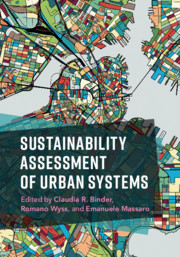Book contents
- Sustainability Assessment of Urban Systems
- Sustainability Assessment of Urban Systems
- Copyright page
- Contents
- Preface
- Acknowledgments
- Contributors
- General Introduction
- Part I Theoretical Background
- Part II Integrative Approaches for Sustainability Assessment
- 6 A Mixed-Method, Dialogue-Based Approach to Sustainability Assessments: Fostering Learning for Sustainable Development
- 7 Sustainability Assessment: Integrative Concept, Methodology, and Examples
- 8 Sustainability Solution Spaces
- 9 Assessing Urban Sustainability through Participatory Multi-Criteria Approaches (PMCAs): An Updated Comparative Analysis
- Part III Perspectives on Urban Sustainability
- Part IV Focal Points of Urban Sustainability
- Index
- References
6 - A Mixed-Method, Dialogue-Based Approach to Sustainability Assessments: Fostering Learning for Sustainable Development
from Part II - Integrative Approaches for Sustainability Assessment
Published online by Cambridge University Press: 27 March 2020
- Sustainability Assessment of Urban Systems
- Sustainability Assessment of Urban Systems
- Copyright page
- Contents
- Preface
- Acknowledgments
- Contributors
- General Introduction
- Part I Theoretical Background
- Part II Integrative Approaches for Sustainability Assessment
- 6 A Mixed-Method, Dialogue-Based Approach to Sustainability Assessments: Fostering Learning for Sustainable Development
- 7 Sustainability Assessment: Integrative Concept, Methodology, and Examples
- 8 Sustainability Solution Spaces
- 9 Assessing Urban Sustainability through Participatory Multi-Criteria Approaches (PMCAs): An Updated Comparative Analysis
- Part III Perspectives on Urban Sustainability
- Part IV Focal Points of Urban Sustainability
- Index
- References
Summary
Given the persistent challenges of governing natural resources sustainably, there is an urgent need for comprehensive sustainability assessments that enable holistic understanding of current and future development scenarios. To spur necessary action, these assessments must also foster joint learning among multiple stakeholders. In this chapter, we present the ‘Sustainability Wheel’, a mixed-method, dialogue-based approach for assessing the sustainability of resource governance systems. The approach combines the transparent identification of general sustainability principles, the regional contextualisation of these as subprinciples/indicators, and the scoring of the indicators based on deliberative dialogue in interdisciplinary teams, drawing on shared knowledge and understandings. Using the approach to examine sustainable water governance in the Swiss Alps, we demonstrate its effectiveness in integrating multiple perspectives, including those deriving from qualitative and quantitative research, and in facilitating communication with stakeholders. Furthermore, we explore its application to urban systems.
Keywords
- Type
- Chapter
- Information
- Sustainability Assessment of Urban Systems , pp. 141 - 160Publisher: Cambridge University PressPrint publication year: 2020

